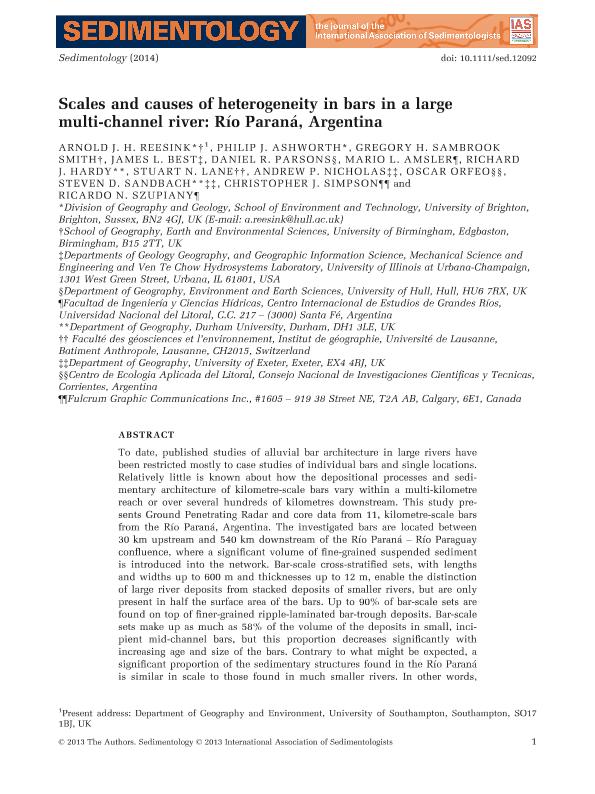Artículo
Scales and causes of heterogeneity in bars in a large multi-channel river: Río Paraná, Argentina
Reesink, Arnold J.; Ashworth, Philip J.; Sambrook Smith, Gregory H.; Best, James L.; Parsons, Daniel R.; Amsler, Mario Luis ; Hardy, Richard J.; Lane, Stuart N.; Nicholas, Andrew P.; Orfeo, Oscar
; Hardy, Richard J.; Lane, Stuart N.; Nicholas, Andrew P.; Orfeo, Oscar ; Sandbach, Stevend D.; Simpson, Christopher J.; Szupiany, Ricardo Nicolas
; Sandbach, Stevend D.; Simpson, Christopher J.; Szupiany, Ricardo Nicolas
 ; Hardy, Richard J.; Lane, Stuart N.; Nicholas, Andrew P.; Orfeo, Oscar
; Hardy, Richard J.; Lane, Stuart N.; Nicholas, Andrew P.; Orfeo, Oscar ; Sandbach, Stevend D.; Simpson, Christopher J.; Szupiany, Ricardo Nicolas
; Sandbach, Stevend D.; Simpson, Christopher J.; Szupiany, Ricardo Nicolas
Fecha de publicación:
06/2014
Editorial:
Wiley
Revista:
Sedimentology
ISSN:
0037-0746
Idioma:
Inglés
Tipo de recurso:
Artículo publicado
Clasificación temática:
Resumen
To date, published studies of alluvial bar architecture in large rivers have been restricted mostly to case studies of individual bars and single locations. Relatively little is known about how the depositional processes and sedimentary architecture of kilometre-scale bars vary within a multi-kilometre reach or over several hundreds of kilometres downstream. This study presents Ground Penetrating Radar and core data from 11, kilometre-scale bars from the Río Paraná, Argentina. The investigated bars are located between 30 km upstream and 540 km downstream of the Río Paraná – Río Paraguay confluence, where a significant volume of fine-grained suspended sediment is introduced into the network. Bar-scale cross-stratified sets, with lengths and widths up to 600 m and thicknesses up to 12 m, enable the distinction of large river deposits from stacked deposits of smaller rivers, but are only present in half the surface area of the bars. Up to 90% of bar-scale sets are found on top of finer-grained ripple-laminated bar-trough deposits. Bar-scale sets make up as much as 58% of the volume of the deposits in small, incipient mid-channel bars, but this proportion decreases significantly with increasing age and size of the bars. Contrary to what might be expected, a significant proportion of the sedimentary structures found in the Río Paraná is similar in scale to those found in much smaller rivers. In other words, large river deposits are not always characterized by big structures that allow a simple interpretation of river scale. However, the large scale of the depositional units in big rivers causes small-scale structures, such as ripple sets, to be grouped into thicker cosets, which indicate river scale even when no obvious large-scale sets are present. The results also show that the composition of bars differs between the studied reaches upstream and downstream of the confluence with the Río Paraguay. Relative to other controls on downstream fining, the tributary input of fine-grained suspended material from the Río Paraguay causes a marked change in the composition of the bar deposits. Compared to the upstream reaches, the sedimentary architecture of the downstream reaches in the top ca 5 m of mid-channel bars shows: (i) an increase in the abundance and thickness (up to metre-scale) of laterally extensive (hundreds of metres) fine-grained layers; (ii) an increase in the percentage of deposits comprised of ripple sets (to >40% in the upper bar deposits); and (iii) an increase in bar-trough deposits and a corresponding decrease in bar-scale cross-strata (<10%). The thalweg deposits of the Río Paraná are composed of dune sets, even directly downstream from the Río Paraguay where the upper channel deposits are dominantly fine-grained. Thus, the change in sedimentary facies due to a tributary point-source of fine-grained sediment is primarily expressed in the composition of the upper bar deposits.
Palabras clave:
Bars
,
Channel Deposits
,
Dunes
,
Facies Model
,
Gpr
,
Large Rivers
,
Río Paraná
Archivos asociados
Licencia
Identificadores
Colecciones
Articulos(CECOAL)
Articulos de CENTRO DE ECOLOGIA APLICADA DEL LITORAL (I)
Articulos de CENTRO DE ECOLOGIA APLICADA DEL LITORAL (I)
Articulos(INALI)
Articulos de INST.NAC.DE LIMNOLOGIA (I)
Articulos de INST.NAC.DE LIMNOLOGIA (I)
Citación
Reesink, Arnold J.; Ashworth, Philip J.; Sambrook Smith, Gregory H.; Best, James L.; Parsons, Daniel R.; et al.; Scales and causes of heterogeneity in bars in a large multi-channel river: Río Paraná, Argentina; Wiley; Sedimentology; 61; 4; 6-2014; 1055-1085
Compartir
Altmétricas



